President Monson Announces Four New Temples
Contributed By Sarah Jane Weaver, Church News associate editor
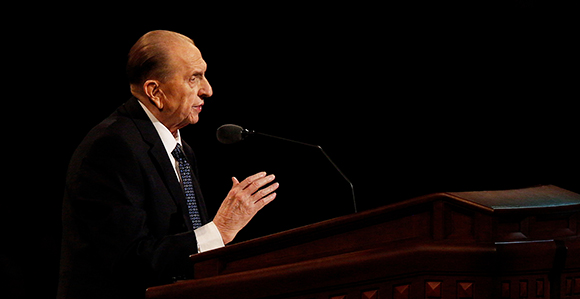
President Thomas S. Monson speaks during the Sunday morning session of general conference on April 3, 2016.
Related Links
President Thomas S. Monson began his address in the Sunday morning session of the 186th Annual General Conference by announcing that in the coming months and years, four new temples will be built.
Their locations are Harare, Zimbabwe; Quito, Ecuador; Belém, Brazil; and a second temple in Lima, Peru.
“When I became a member of the Quorum of the Twelve Apostles in 1963, there were 12 operating temples in the entire Church,” said President Monson. “With the dedication of the Provo City Center Temple two weeks ago, there are now 150 temples in operation throughout the world. How grateful we are for the blessings we receive in these holy houses.”
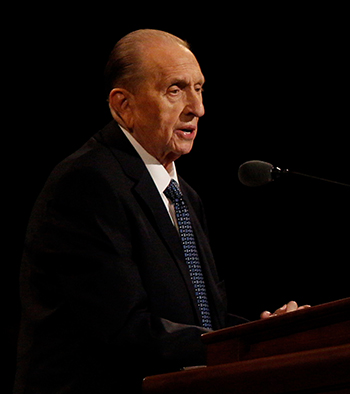
President Thomas S. Monson speaks during the Sunday morning session of general conference on April 3, 2016.
The four temples announced Sunday will increase the total number of new temples announced or under construction to 27. An additional four existing temples are being renovated.
Harare, Zimbabwe
Zimbabwe is home to approximately 14.2 million people and more than 26,000 members of the Church. The temple planned for Harare, Zimbabwe’s capital and most populous city, will be the first in the country.
The Church has three operating temples in Africa (Aba, Nigeria; Accra, Ghana; and Johannesburg, South Africa), one under construction (Kinshasa, Democratic Republic of the Congo), and three more announced (Abidjan, Ivory Coast; Durban, South Africa; and Harare, Zimbabwe). The closest temple to Harare is in Johannesburg, a 13-hour drive.
As early as 1925, the Church had members in Southern Rhodesia—the name of the nation of Zimbabwe prior to 1980. Peter and Elizabeth DuPlooy, who lived 62 miles out of what is now the city of Harare, were baptized on March 10, 1925, while on a visit to South Africa.
Five years later the Church sent missionaries to the new Rhodesia District, and they worked in the area for five years due to the city’s distance from mission headquarters.
Members continued contact through letters written to the South African Mission headquarters that ran news in the mission publication The Southern Cumorah Cross.
In 1950, missionaries returned to Rhodesia. On February 1, 1951, the first convert, Hugh Hodgkiss, was baptized; the Salisbury (now called Harare) Branch was organized in September 1951.
Meetinghouses were built and dedicated in Rhodesia in the late 1960s. Elder Mark E. Petersen of the Quorum of the Twelve Apostles dedicated the Salisbury Branch meetinghouse on September 17, 1967. Elder Marion G. Romney of the Quorum of the Twelve Apostles dedicated the Bulawayo Branch meetinghouse on September 3, 1968.
On April 18, 1980, Britain recognized Rhodesia's independence and the country's name was officially changed to Zimbabwe. On July 1, 1987, the Zimbabwe Harare Mission was organized from the South Africa Johannesburg Mission. In 1988, selections from the Book of Mormon were translated in Shona.
President Gordon B. Hinckley, on a five-country tour of Africa, visited Zimbabwe on February 18, 1998, and spoke to about 1,500 Latter-day Saints.
On December 12, 1999, the Harare Zimbabwe Stake was organized by Elder Dennis E. Simmons of the Seventy.
Quito, Ecuador
Ecuador is home to approximately 15.8 million people and more than 230,000 members of the Church. The temple in Quito, Ecuador’s capital and second most populous city, will be the country’s second temple.
Located on the equator on the Pacific Coast side of South America, Ecuador is divided into three zones by two ranges of Andes mountains. Its population speaks Spanish or Quechua.
A telephone call from Elder Spencer W. Kimball, then of the Quorum of the Twelve Apostles, to President J. Averil Jesperson of the Andes Mission in Lima, Peru, on September 22, 1965, directed the beginning of missionary work in Ecuador. Four missionaries were sent to Quito, and Elder Kimball visited the city on October 9. Less than a month after Elder Kimball's visit, nine people were baptized in Alangasi de la Merced, located about 50 miles southeast of Quito.
Missionary work progressed rapidly. In the city of Guayaquil missionary work began on January 28, 1966. When the Ecuador Mission, headquartered in Quito, was created on August 1, 1970, membership was 1,000. Ecuador's first stake was organized in Guayaquil in June 1978. A second mission in the country was organized in Guayaquil one month later. Some early missionary efforts were conducted among the Otavalo Indians near Quito, among whom the first all-Lamanite stake in South America was organized in 1981. In 1989, the headquarters for the South America North Area was moved from Lima, Peru, to Quito, Ecuador.
Membership in 1999 approached 150,000 in 32 stakes.
Although the construction of a temple for Guayaquil was announced in March 1982, it was not finished and dedicated until August 1, 1999.
Two years before the dedication, President Gordon B. Hinckley became the first Church President to visit Ecuador. He toured the temple under construction and, in two meetings, described to 15,000 Ecuadoran Church members how he had been impressed to find the site several years earlier. At a regional conference on July 31, 1999, President Hinckley spoke to nearly 22,000 members and told them, in contemplation of the temple dedication the following day, “This is a day to be remembered by Latter-day Saints for many years to come.”
Belém, Brazil
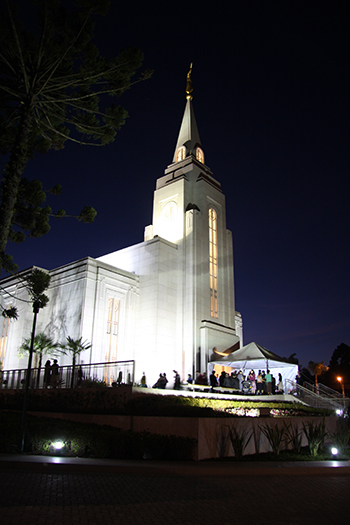
President Thomas S. Monson dedicated the Curitiba Brazil Temple on June 1, 2008. Photo by Gerry Avant.
Nearly 1.3 million of Brazil’s 204 million people are members of the Church. Six operating temples (Campinas, Curitiba, Manaus, Porto Alegre, Recife, and São Paulo) currently dot the country. Another temple is under construction in Fortaleza, and two others are announced for Rio de Janeiro and now Belém.
Brazil, a federal republic with a Portuguese-speaking population, covers almost half the continent of South America.
The first known Church member in Brazil was Max Richard Zapf, who was baptized in Germany in August 1908 and immigrated to Brazil in 1913. After many years with no Church contact, Brother Zapf and his family learned that Augusta Kuhlmann Lippelt and her four children, who had also joined the Church in Germany before immigrating to Brazil in 1923, were living in the small southern Brazilian town of Ipomoea. Augusta's husband, Roberto, although not a member when he moved his family to Brazil, was baptized several years later. The Zapf family soon relocated to be with their new friends, the Lippelt family. These two families represented the beginning of the Church's permanent presence in Brazil.
The president of the South American Mission in Buenos Aires, Argentina, first visited Brazil in 1927 and returned with the elders to begin missionary work in September 1928. A branch was organized in Joinville in 1930, and the first Church-owned meetinghouse in South America was dedicated a year later in Joinville.
A mission was created and headquartered in Sao Paulo, Brazil, on May 25, 1935. A Portuguese edition of the Book of Mormon was published in 1939.
In 1954, President David O. McKay became the first Church President to visit Brazil. At the end of the 1950s, membership totaled 3,700, and by the time the Sao Paulo Temple was dedicated in 1978 it had reached 54,000. After 1978, in part due to the revelation extending priesthood to all worthy males, Church growth became extraordinary. By 1990, membership exceeded 300,000, and as the 1990s ended, membership totaled more than 700,000.
The Brazil Area was created in August 1987. On February 2, 1986, with the creation of the Campinas Brazil Castelo Stake, Brazil became the third country outside the United States to have 50 stakes. When the Sao Leopoldo Brazil Stake was created December 5, 1993, Brazil reached 100 stakes, the second country outside the United States to do so.
In October 1993, construction began on a missionary training center in Sao Paulo, the Church’s second largest MTC. The seven-story building, capable of accommodating 750 missionaries, was dedicated May 18, 1997, by Elder Russell M. Nelson of the Quorum of the Twelve Apostles. In October 1998, North American missionaries called to Brazil began receiving nearly half of their training at the Brazil Missionary Training Center. The program to send North American missionaries to Brazil for four weeks of training enabled them to be immersed in the Brazilian culture and Portuguese language in a controlled environment.
The program was so successful that in April 2000 the first 22 North American missionaries were sent to Brazil for their full eight weeks of training.
The Sao Paulo Stake, the first in South America, was organized on May 1, 1966. Ten years later, Brazil had 10 stakes, and a temple had been announced for Sao Paulo. President Spencer W. Kimball presided over a cornerstone ceremony for the temple on March 9, 1977. The temple was dedicated October 30, 1978. President Gordon B. Hinckley dedicated the Recife Brazil Temple on December 15, 2000. While President James E. Faust, Second Counselor in the First Presidency, attended the groundbreaking of the Porto Alegre Temple, he also was made an honorary citizen of Sao Paulo, in recognition of his lifelong ties to that city and to Brazil, where he served as a missionary. President Hinckley dedicated the Recife Brazil Temple on December 15, 2000; the Porto Alegre Brazil Temple on December 17, 2000; and the Campinas Brazil Temple on May 17, 2002. President Thomas S. Monson dedicated the Curitiba Brazil Temple on June 1, 2008. President Dieter F. Uchtdorf dedicated the Manaus Brazil Temple on June 12, 2012.
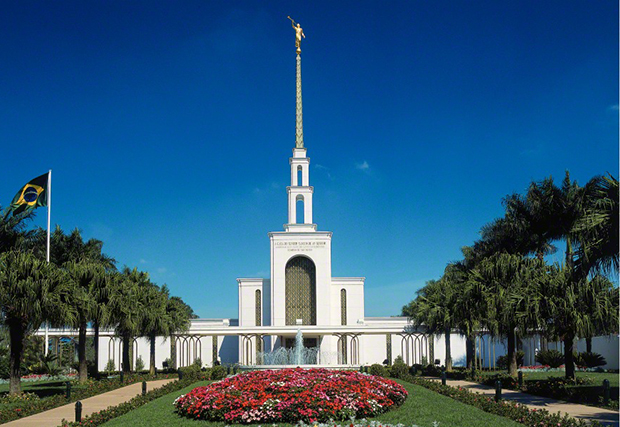
The Sao Paulo Brazil Temple—South America's first LDS temple—was dedicated on October 30, 1978.
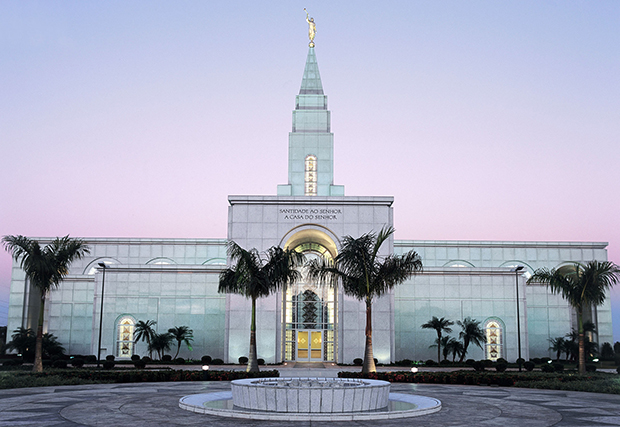
The Campinas Brazil Temple is evidence of many years of missionary work in Brazil.
Lima, Peru
Peru is home to approximately 30 million people and 557,000 members of the Church. The country has two operating temples (Lima and Trujillo) and two temples that have been announced (Arequipa and the new temple announced in Lima). The first temple in Lima was dedicated in 1986.
Located on the Pacific Coast side of South America, Peru is a constitutional republic with a population that speaks Spanish, Quechua, and Aymara.
Prior to 1956, Latter-day Saint families living in Peru held group meetings, but no organized missionary work was done.
Frederick S. Williams, a former mission president in Argentina and Uruguay, moved to Peru with his family in 1956 and soon contacted Church headquarters for permission to organize a branch and begin missionary work.
A branch in Lima was organized on July 8, 1956, by Elder Henry D. Moyle of the Quorum of the Twelve Apostles. A building for branch meetings was purchased the following November.
The Andes Mission, headquartered in Lima, was established on November 1, 1959. At the time, there were five branches and 300 members.
The mission was divided in 1961. When the first stake was organized in Lima in 1970, membership was 10,771. That same year the mission was divided and renamed the Peru Mission.
Growth continued as local leaders assumed priesthood leadership. At a two-day area conference in Lima in 1977, presided over by President Spencer W. Kimball, 7,900 attended. Four years later in 1981, President Kimball announced a temple for Lima, which was completed and dedicated on January 10, 1986. Twelve years later, a new missionary training center, with capacity for 150 missionaries and room for expansion, was dedicated by Elder Russell M. Nelson of the Quorum of the Twelve Apostles.
Just 32 years after missionary work started in Peru, seven stakes in Lima were created in one weekend in 1988 by Elder M. Russell Ballard of the Quorum of the Twelve Apostles. Lima then had the second largest number of stakes of any metropolitan area outside the United States. Although Peru experienced political instability, the Church continued to grow.
In July 1993, the Peru Chiclayo Mission was created, which included the highland Andes bordering Ecuador. Seven additional stakes were created from October 1992 to October 1994, and 18 stakes were created from October 1994 to October 1996.
President Gordon B. Hinckley visited Lima on November 8–9, 1996, and spoke to some 35,000 people. A new area, the South America West Area, was created in 1998, comprising only Peru and Bolivia, with headquarters in Lima.
President Dieter F. Uchtdorf, Second Counselor in the First Presidency, dedicated the Trujillo Peru Temple on June 21, 2015.
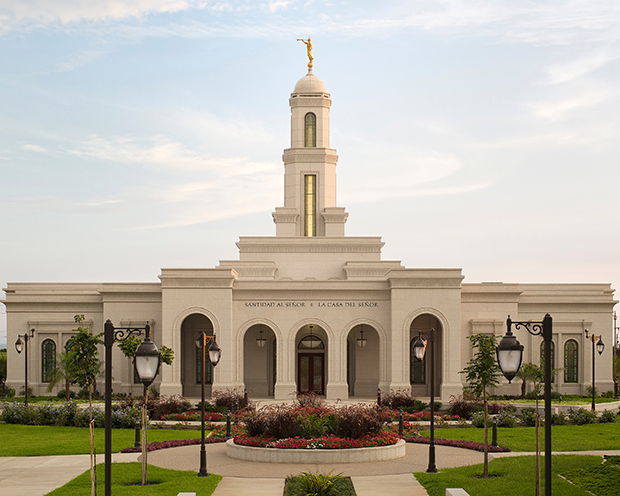
The Trujillo Peru Temple was the second LDS temple in Peru.
(Source: Deseret News Church Almanac)
